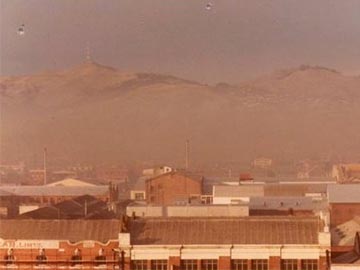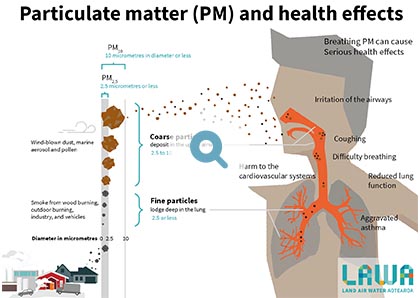
Updated air quality picture for Canterbury now available
An updated Air Quality National Picture Summary confirms air quality in New Zealand towns, including Canterbury, is generally good and has improved over the past 15 years.
However, the update from LAWA (Land, Air, Water Aotearoa) also highlights there is still work to be done to reduce levels of winter air pollution in some places across the country.
Canterbury’s air quality
Christchurch’s air quality has come a long way since this photo was taken in 1983. Smoggy days are a thing of the past in Christchurch, thanks to the community making changes like adopting cleaner home heating.

Christchurch smog – taken at 9am on 26 July 1983
LAWA project chair and Environment Canterbury director of science Dr Tim Davie said that over the years, regional councils and unitary authorities have worked with communities affected by air pollution to bring about improvements. "In places like Christchurch, long-term PM10 monitoring results show how a place can go from over 40 exceedances a year to few – or none, because of communities changing their heating in response to council education and incentives.”
However, there is still work to do in other parts of Canterbury to improve air quality. So far this year, Kaiapoi, Rangiora, Woolston, Timaru (at Anzac Square) and Washdyke have all had at least one exceedance of PM10 measurements.
The National Environmental Standards for Air Quality (NESAQ) requires that all Canterbury airsheds have no more than one high PM10 day per year, and we are only part-way through the winter season when concentrations are usually at their highest.
Causes of air pollution in Canterbury
Environment Canterbury has monitored air quality in 13 towns and cities across the region.
During the winter our cold, still, frosty days mean the smoke from home heating isn’t blown away overnight and gets trapped until morning when the air warms up or the wind picks up. The particulates from this smoke (and from sea salt, dust and cars) are known as PM10 (particulate matter – small airborne particles less than 10 micrometres across). These tiny particles can get deep into our lungs and cause health issues for some people.
PM2.5 (particulate matter – very small airborne particles that are less than 2.5 micrometres across) is a subset of PM10. The main source of PM2.5 in Canterbury towns and cities is from smoke from home heating. Other sources of PM10 may include industrial and commercial processes, motor vehicles and rural burning, as well as natural sources.
Annual average PM2.5 and PM10 concentrations in most Canterbury towns are below national guidelines. During still, cold days in winter, daily average PM2.5 and PM10 concentrations can exceed national guidelines, with the main source of emissions usually being from home heating. An exception to this is Washdyke in South Canterbury, which has different sources of air pollution to other places in Canterbury. Most of the PM10 measured in Washdyke are coarse, not fine particles, which indicates sources such as dust rather than home heating.
Air quality updates from LAWA
Alongside the National Picture Summary for Air Quality, LAWA has released a series of upgrades to the LAWA Air Quality website topic to make monitoring results collected by regional councils and unitary authorities more accessible.
The upgrades include an interactive desktop map that can be filtered to show how yesterday’s air quality and annual air quality in New Zealand towns measure up, as well as an exceedance counter on site pages.
Dr Davie said the upgrades to the LAWA air quality topic allow people can see what air quality is like in their town at a glance and better understand the sources of air pollution, the effects of different interventions, and the role of weather and landscape.
Visit the LAWA air quality topic page to explore the data available.
Health effects of breathing polluted air
Breathing air that is polluted with coarse and fine particles is bad for human health, with the impacts ranging from respiratory illness to high blood pressure, and in the worst cases premature death.
When breathed in, PM10 can deposit in the upper airways and cause irritation, as well as affecting people’s lungs and heart. PM2.5 can lodge deep into our lungs and reach the bloodstream, potentially leading to respiratory diseases, heart attacks, lung cancer, and reduced life expectancy.
How you can help improve air quality
- Use clean heating: Switch from your wood burner to a non-emitting home heating source if possible. Heatpumps, pellet burners, or ultra-low emission burners are better alternatives.
- Burn smoke free: It’s important that if burning wood, the wood is dry, seasoned and non-treated. Get your fire going quickly, keep it burning hot, and don’t damp it down overnight – see warmercheaper.co.nz/burning for tips on your technique.
- Reduce outdoor burning: Refrain from burning waste outdoors (especially plastic, treated timber and toxic waste).
- Reduce transport emissions: Choose to walk, cycle, or use public transport when possible. Service your car regularly to reduce exhaust fumes. Electric and hybrid cars don’t contribute the same emissions as petrol or diesel vehicles, so if you’re if in the position to switch, they’re a great option.
- Report pollution: If you see excessive air pollution that doesn’t look quite right, contact your regional council or unitary authority to report it. Many councils have processes for providing advice to the responsible party, and in serious cases may enforce regulations.
More information
LAWA is a partnership between New Zealand’s 16 regional councils and unitary authorities and other like-minded agencies, which aims to connect New Zealanders with their environment by sharing environmental data and information.
Learn more about air quality:

